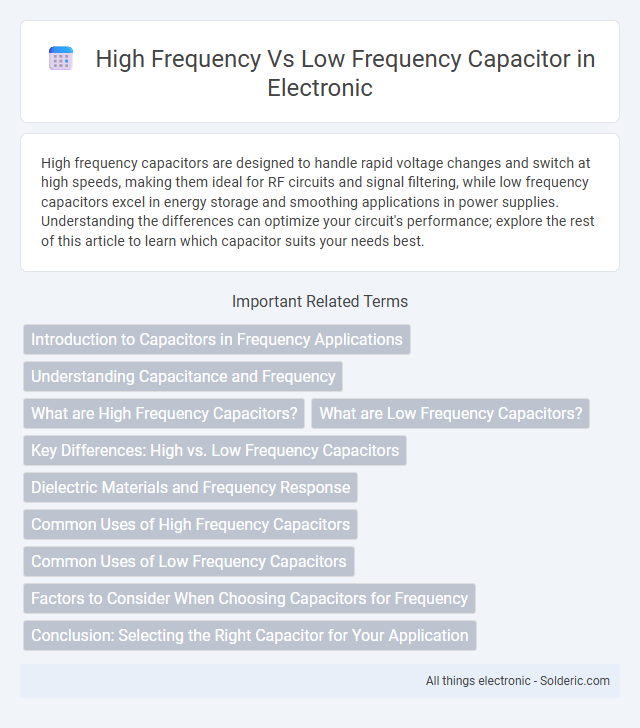High frequency capacitors are designed to handle rapid voltage changes and switch at high speeds, making them ideal for RF circuits and signal filtering, while low frequency capacitors excel in energy storage and smoothing applications in power supplies. Understanding the differences can optimize your circuit's performance; explore the rest of this article to learn which capacitor suits your needs best.
Comparison Table
| Feature | High Frequency Capacitor | Low Frequency Capacitor |
|---|---|---|
| Frequency Range | Above 100 kHz | Below 100 kHz |
| Dielectric Material | Mica, ceramic, film | Electrolytic, paper, tantalum |
| ESR (Equivalent Series Resistance) | Low ESR for minimal losses | Higher ESR, less efficient at high frequencies |
| Applications | RF circuits, oscillators, filtering high-speed signals | Power supply smoothing, audio circuits, DC filtering |
| Size | Smaller size for the same capacitance | Larger size for the same capacitance |
| Temperature Stability | High stability with minimal capacitance variation | Moderate to low stability |
| Cost | Generally higher cost | Typically lower cost |
Introduction to Capacitors in Frequency Applications
High frequency capacitors are designed with low equivalent series resistance (ESR) and inductance to efficiently filter and stabilize signals in radio frequency (RF) and microwave applications. Low frequency capacitors typically feature higher capacitance values with stable dielectric materials suited for power supply smoothing and audio circuits. Selecting the appropriate capacitor type depends on the operating frequency, as high frequency capacitors must minimize parasitic effects to maintain performance in GHz range signals.
Understanding Capacitance and Frequency
High frequency capacitors feature low equivalent series resistance (ESR) and inductance, enabling efficient performance in RF and switching applications by maintaining stable capacitance at gigahertz ranges. Low frequency capacitors have higher capacitance values but exhibit increased ESR and inductive reactance, making them suitable for power filtering and energy storage in audio and power supply circuits. Understanding capacitance frequency response helps engineers select capacitors that optimize circuit stability and signal integrity across different electronic applications.
What are High Frequency Capacitors?
High frequency capacitors are designed to operate effectively at radio frequencies and above, typically ranging from megahertz (MHz) to gigahertz (GHz) ranges, minimizing energy loss and ensuring signal integrity in fast-switching circuits. These capacitors use materials like ceramic, mica, or film to provide low equivalent series resistance (ESR) and low inductance, which is critical for filtering, tuning, and impedance matching in RF and microwave applications. Your choice of high frequency capacitors influences the performance of communication devices, oscillators, and high-speed digital circuits where precise capacitance stability and minimal signal distortion are required.
What are Low Frequency Capacitors?
Low frequency capacitors are designed to operate efficiently within lower frequency ranges, typically below 1 kHz, making them suitable for power supply filtering and audio applications. These capacitors usually have larger capacitance values and are built with materials like electrolytic or tantalum to handle high capacitance at low frequencies. Their construction prioritizes stability and energy storage over rapid charge-discharge cycles, distinguishing them from high frequency capacitors used in RF circuits.
Key Differences: High vs. Low Frequency Capacitors
High frequency capacitors typically feature low equivalent series resistance (ESR) and inductance, enabling them to operate efficiently at frequencies above 1 MHz, while low frequency capacitors are designed for stable performance below 100 kHz with higher capacitance values. The dielectric materials differ significantly, with high frequency capacitors often using ceramics or films for minimal loss, whereas low frequency capacitors may use electrolytic or tantalum materials suited for energy storage. Understanding these key differences helps optimize your circuit design for signal integrity and power management based on the operating frequency range.
Dielectric Materials and Frequency Response
High frequency capacitors typically utilize dielectric materials like ceramic or mica, which offer low equivalent series resistance (ESR) and minimal dielectric losses at frequencies above 1 MHz. Low frequency capacitors often use electrolytic or film dielectrics, providing higher capacitance but exhibiting increased losses and reduced stability at high frequencies. Frequency response is significantly influenced by dielectric properties, where high frequency capacitors maintain consistent capacitance and low dissipation factors, while low frequency types may show capacitance drop-off and higher losses as frequency increases.
Common Uses of High Frequency Capacitors
High frequency capacitors are primarily used in RF circuits, signal processing, and telecommunications to filter, tune, and stabilize high-speed signals. They are essential in applications such as oscillators, frequency mixers, and antenna matching networks, where rapid response and minimal signal loss are critical. These capacitors enable efficient operation in wireless devices, radar systems, and high-frequency power supplies.
Common Uses of Low Frequency Capacitors
Low frequency capacitors are commonly used in power supply filtering, audio signal coupling, and motor start applications due to their ability to handle higher voltage and current levels. These capacitors excel in smoothing out voltage fluctuations in AC to DC conversion processes and stabilizing audio frequency signals. Their robust construction makes them ideal for industrial equipment, electric motors, and audio amplifiers where long-term reliability is essential.
Factors to Consider When Choosing Capacitors for Frequency
High frequency capacitors require low equivalent series resistance (ESR) and low inductance to handle rapid voltage changes, making ceramic and mica types ideal due to their stability and minimal signal loss. Low frequency capacitors often prioritize higher capacitance values and voltage ratings, with electrolytic capacitors commonly used in power supply filtering and energy storage applications. When selecting capacitors for your circuit, consider frequency range, voltage, capacitance, and the capacitor's dielectric material to ensure optimal performance and longevity.
Conclusion: Selecting the Right Capacitor for Your Application
High frequency capacitors excel in applications requiring rapid charge and discharge cycles, minimizing parasitic inductance and providing stable performance at MHz or GHz ranges. Low frequency capacitors are suited for energy storage, filtering, and smoothing in power circuits operating at lower frequencies up to a few kHz. Selecting the right capacitor for your application depends on frequency requirements, voltage ratings, and desired performance to ensure efficiency and reliability.
High frequency vs low frequency capacitor Infographic

 solderic.com
solderic.com